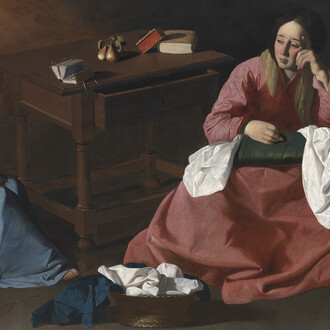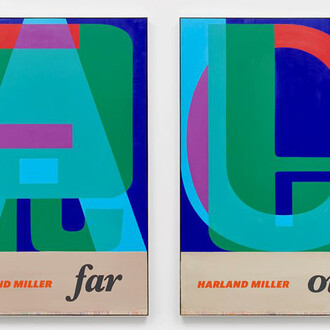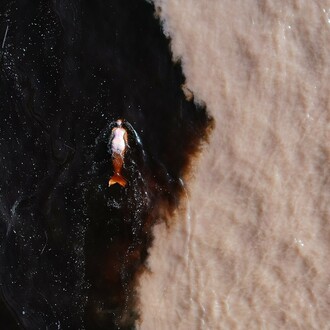Sundaram Tagore Gallery is pleased to announce our first solo exhibition of work by New York-based Nigerian artist Osi Audu. The artist (b. 1956, Abraka, Nigeria), whose work is in the collections of the Smithsonian National Museum of African Art in Washington, DC, and The British Museum in London, has exhibited widely in the U.K. since the 1980s. Previously based in London, Audu has participated in several noted shows in the capital at institutions including the Africa Centre, Science Museum, The British Museum, and Horniman Museum and Gardens.
Audu has spent years investigating ideas surrounding human consciousness in Yoruba traditions of Nigeria as well as Western science and philosophy. The new series of sculptural works he created for Sundaram Tagore London are composed of vibrant strands of yarn piercing canvas. The richly textured surfaces are inspired by the phenomenon of goosebumps (also known as piloerection).
Audu has long been fascinated by textured surfaces in the natural world and within the human body such as the papillae (tiny nodules) that carpet the surface of our tongues or the minuscule hairs that line the cochlea in our ears. Most recently he became interested in how emotions or experiences trigger a reflexive response of the sympathetic nervous system resulting in the bristling of hairs. “When people are deeply moved, gripped by fear or overwhelmed by beauty, these intangible emotions generate a very physical, tangible expression. My work has always been about what you can’t see, effecting and creating what you can”, Audu says.
Growing up in Lagos, Audu was highly attuned to the relationship between visible and invisible dimensions of being. This idea of dualism is deeply ingrained in Nigerian culture and daily life. Audu remembers watching Yoruba egungun masquerades in which performers shroud themselves in colorful garments festooned with fabric and yarn. The outfits represent a manifestation of the spirits of departed ancestors and are a means of connecting the living world with a metaphysical, spiritual realm.
Although Audu began his practice creating geometric paintings and drawings, it was only natural that he slowly gravitated toward incorporating yarn into his work. In addition to seeing yarn in egungun masquerade festivals throughout his childhood, Audu has vivid memories of watching craftsmen working on wooden looms to create aṣọ òkè, a traditional striped cloth used to make garments for weddings, funerals and religious festivals.
He began creating multimedia works inspired by the tradition of juju (ceremonial offerings to ancestors or members of the spirit world) using black yarn and safety pins. He then started painting head-like forms on canvas exploring the Yoruba idea of an inner head (orí inú) and a physical, external head (orí òde) using patches of black and white yarn to activate certain areas of the canvas.
His current series, on view at the London gallery, marks a new direction in his use of yarn as he takes a purely abstract approach. “Abstraction, as a primal, formal language, is indigenous to all the world’s cultures”, says Audu, whose own work draws from the history of African art where abstract forms are often used to explore spiritual concepts and human consciousness.
For Goosebumps, Audu begins by applying gesso to the surface of the canvas. He then pierces the canvas with a needle and threads through strands of yarn to form broad columns of color. Finally, he treats the yarn to stiffen each strand so that it protrudes from the surface. The satin sheen of the yarn casts a colored reflection on the slick surface of the canvas creating a luminous effect. The columns are inspired by aṣọ òkè cloth, but Audu also sees the simple repetitive pattern as having a calming effect on viewers’ minds.
The dimensionality of the canvases coax viewers to examine the work from various angles. Looking at the pieces elicits a visceral reaction. “There is almost a feeling of a current of electric energy one gets from gazing at this kind of textured surface”, says Audu. “Art has the potential to take us to places in our psyche that are full of energy—places pulsating with life-affirming energy and joy”.
Nigerian-American artist Osi Audu focuses on the dualism of form and void as well as the tangible and intangible. Using acrylic, graphite, pastel, yarn and wool on canvas or paper, he examines scientific, philosophical and cultural concepts surrounding the relationship between mind and body. Audu draws from his upbringing in Nigeria and his work often alludes to the Yoruba people’s concepts of human consciousness.
Audu was born in Abraka, Nigeria, in 1956. He received his undergraduate degree in fine arts from the Obafemi Awolowo University, Ilé-Ifẹ̀, Nigeria, and a master’s degree in painting and drawing at the University of Georgia, Athens, United States. In 1994, he earned a postgraduate certificate in education from the University of Kent in Canterbury, United Kingdom.
Audu’s work has been widely exhibited in museums and galleries in the United States, Asia, the United Kingdom, Europe, and Africa. His work can be found in the collections of the Smithsonian National Museum of African Art, Washington, DC; The British Museum, Horniman Museum and Gardens, and Wellcome Trust, London; The Newark Museum of Art, New Jersey; Samuel Dorsky Museum of Art, New York; Hood Museum of Art, Dartmouth, New Hampshire; National Gallery of Modern Art, Lagos; and Nigeria High Commission, London, among others.
Audu’s work was in the first Gwangju Biennale in 1995 and in Frontiers Reimagined at the 56th Venice Biennale in 2015. Audu’s work is on view at the residence of the United States Ambassador to Nigeria in Abuja, as part of the U.S. Department of State’s Art in Embassies Program.















